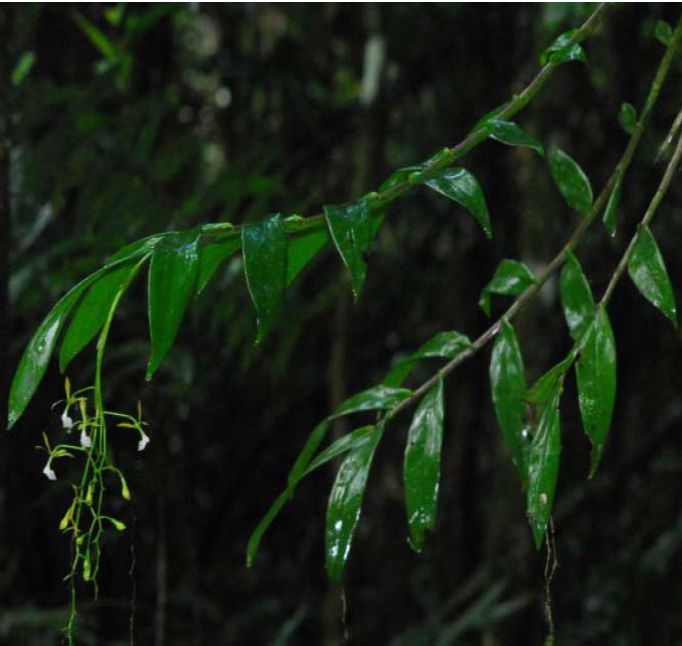

Epidendrum pluriracemosum Hágsater & E.Santiago 2013 GROUP Pseudepidendrum SUBGROUP Pleuriracemosum TYPE for the subgroup
TYPE Photo by Ravet/TYPE Drawing by © Jimenez and The AMO Herbaria Website





Common Name The Many Successive Raceme Epidendrum
Flower Size 1.2” [3 cm]
Found in Surinam, French Guiana, and in the states of Amapá and Pará, Brazil in rainforests at elevations of 200 to 600 meters as a medium to large sized, warm growing epiphyte or rarely lithophyte with simple, cane-like, thin, straight stems carrying 6 to 12, all along the apical half of the stem, articulate, alternate, subcoriaceous, narrowly elliptic to elliptic, short-acuminate, minutely apiculate, margin entire leaves that blooms in the winter, spring and summer on a terminal, without a spathe, racemose, producing new racemes over several years from the same peduncle, thus pluriracemose, peduncle 1.2 to 2.4” [3 to 6 cm] long, thin, laterally compressed, straight, subtended by 1 to 2 basal, tubular towards the base, conduplicate above, acute bracts, raachis 6.4” [16 cm] long, thin, flexuous, successively generally 2, 6 to 18 per raceme, many flowered inflorescence with much shorter than the ovary, triangular, acuminate, amplexicaul floral bracts and carrying resupinate, greenish yellow to green flowers with an immaculate white lip and column.
"Epidendrum pluriracemosum belongs to the GROUP Pseudepidendrum which is characterized by caespitose plants, cane-like stems, acute to acuminate leaves, usually apical inflorescence, the mostly filiform petals and the lip usually 3-lobed with 3 parallel fleshy keels, the apical lobe often bifurcate, the “bird-wing” type pollinia, at least the inner pair, and SUBGROUP Pleuriracemosum which has a racemose and few-flowered inflorescence on an elongate peduncle, usually producing new racemes over the years and thus pluri-racemose, the rachis is elongate, and thus lax flowered, the flowers bicolored, basically green to brown with the lip white to purple, spotted or not. The species is recognized by the plants 16 to 30" [40 to 75 cm} tall, green, concolor leaves, small flowers with sepals .36 to .42" [9 to 10.5 mm] long, sepals green, the lip and column immaculate white, rachis flexuous, peduncle short, subtended by 1 to 2 tubular bracts. Epidendrum unguiculatum (C.Schweinf.) Garay & Dunst. has larger green flowers with the sepals .72 to .8" [18 to 20 mm] long, with the lip and apex of the column white, the calli occasionally purple, the 3-lobed lip has flabellate lateral lobes, and the mid-lobe is sub-quadrate, with the isthmus parallel sided at the base, and forms a pair of linear-oblong lobes at the apex. Epidendrum oenochrochilum Hágsater, Ric. Fernández & E.Santiago has bicolor leaves, green above, purple ventrally, the flowers with somewhat larger sepals .56 to .6" [14 to 15 mm] long, purple-brown with the ventral surface of the sepals purple-green, the lip yellow-brown to dirty pink, the rachis is straight and the peduncle subtended by 5 to 7 bracts. Epidendrum huamantupanorum Hágsater & E.Santiago is known only from Peru, has somewhat smaller plants, to 16" [40 cm] tall, the flowers copper green with the lip white, the margin hyaline, the calli and ribs lavender, surrounded by a ring of darker lavender; the peduncle of the inflorescence is elongate with up to 7 bracts spread throughout. Epidendrum maroniënse Hágsater & E.Santiago also from the French Guiana has larger flowers, sepals .6 to .68" [15 to 17 mm] long, flowers green with the disc of the lip immaculate white or occasionally the calli tinged purple, and the lip sub-entire with the base widely cuneate." Hagsater etal 2013
Synonyms
References W3 Tropicos, Kew Monocot list , IPNI ; Icones Orchidacearum 14 Plate 1455 Hagsater & Sanchez 2013 see recognition section; Icones Orchidacearum 14 Plate 1463 Hagsater & Sanchez 2013 see recognition section; * Icones Orchidacearum 14 Plate 1476 Hagsater & Santiago 2013 drawing fide; Icones Orchidacearum 14 Plate 1492 Hagsater & Santiago 2013 See recognition section;
--------------------------------------------------------------------------------------------------------------------------